Abstract
Hydrogen is one of the exhaust gases produced by nuclear power stations. Due to the potential danger of incomplete combustion and the emission of hydrogen, hydrogen catalytic combustion is introduced to ensure the safety of nuclear power stations. Palladium is a widely used catalyst for hydrogen catalytic combustion. H2 catalytic combustion on a Pd(111) slab model and Pd38 cluster model were simulated using density functional theory (DFT), in order to analyze the H2 oxidation mechanism on the catalyst surface.
1. Introduction
Hydrogen, H2, is one of the exhaust gases produced by nuclear power stations. In nuclear power stations, large amounts of hydrogen are released into the containment vessel after a coolant loss. H2 is a flammable and explosive gas. An H2 concentration at 4–75.6% (volume concentration) will trigger an explosion when encountering a fire source, which would result in a serious accident. Therefore, the hydrogen produced by a nuclear power station needs to be treated in a timely manner. Many methods of hydrogen elimination have been applied in nuclear power station. H2 catalytic combustion can reduce the H2 concentration, to improve the safety performance of nuclear power stations. One advantage of H2 catalytic combustion is that it can eliminate hydrogen at low concentrations. Another is that H2 catalytic combustion can function at room temperature.
H2 catalytic combustion is a flameless combustion. As early as 1970, Pfefferle studied catalytic combustion [1]. Compared to conventional combustion, catalytic combustion has a higher efficiency, less pollutants, and it is easier to control the combustion temperature. H2 catalytic combustion was first studied by Sharer [2]. Subsequently, Kramer et al. studied low-temperature H2 catalytic combustion on a Pd catalyst [3]. Zhang et al. reported the activity of a Pt catalyst for H2 low-temperature catalytic combustion [4]. From then on, many works on H2 catalytic combustion have been studied by researchers [4,5,6]. So far, Pt [7,8,9,10,11,12,13,14] and Pd [15,16,17] catalysts have been commonly applied for H2 catalytic combustion. The catalytic reaction of H2 and O2 is a basic catalytic oxidation reaction. It is of great significance to select an appropriate catalyst for a heterogeneous catalytic combustion, by studying the adsorption mechanism of reactant molecules on the catalyst surface, especially the reaction rate of reactants on the catalytic sites and the adsorption/desorption effect of the catalytic surface [18].
With the development of modern computers, computational chemistry has made a great deal of progress. Sui et al. studied the H2 catalytic oxidation reaction mechanism on a PdO surface using density functional theory (DFT) [19]. H2 firstly dissociates into adsorbed H on the PdO surface, with an activation energy of 58.6 kJ/mol. Then, the H atom reacts with the O atom in PdO to form OH. Finally, two OH react to form H2O and O, with an activation energy of 58.9 kJ/mol. Qi et al. investigated H2 catalytic combustion on Pt(111) surfaces [18]. At first, H2 and O2 dissociate into adsorbed H and O on the Pt surface, respectively. Then, H and O react to form OH. Finally, OH reacts with H to form H2O. At present, few literature works have systematically studied the mechanism of H2 catalytic combustion using DFT. It is necessary to study the reaction mechanism of H2 catalytic combustion on a Pd metal surface, which is helpful to guide the selection of a catalyst.
In many previous works, the researchers found that the size of particles played an important role in the catalytic system. Tsamis’ group studied the efficiency of Pd-doped porous silicon as a catalyst for hydrogen dissociation [20]. It was found that the catalytic activity of Pd-doped porous silicon was significantly higher than that of a planar surface covered with Pd. Abate [21] studied the effect of the size of Pd particles in H2O2 synthesis. They found that smaller particles of Pd showed a higher rate of combustion. In Huang’s work [22], they studied the influence of the size of Pd particles on Heck reactions. Their work showed that the size of the supported Pd particles were smaller, and the catalytic activity was higher. In this work, we wanted to investigate the effect of particle size on H2 catalytic combustion using DFT calculation. A Pd38 cluster model simulated the small Pd particles and a Pd(111) slab model simulated the large particles in the catalytic system. Comparing the reaction energy barrier of H2 catalytic combustion on the surface of the two models, the influence of model morphology on the catalytic activity was studied. This method can guide the design of a catalyst rationally, through theoretical calculation, so that catalysts can be designed and prepared more efficiently.
2. Computing Method
The DMol3 module of Materials Studio software was applied for DFT calculation of H2 catalytic combustion [23]. In this work, the exchange-correlation energy was calculated using the Perdew–Burke–Ernzerf (PBE) function with generalized gradient approximation (GGA). The wave functions were calculated using a localized double-numerical quality basis set with a polarization d-function (DNP). The effective core potential (ECP) was applied to represent the core electrons of the Pd metal atoms. The k-point mesh was set to 3 × 3 × 1 using Monkhorst–Pack with a thermal smearing of 0.005 hartree. In the configuration optimization, the convergences of the energy, maximum force, and maximum displacement were set as 2.0 × 10−5 Ha, 0.004 Ha/Å, and 0.005 Å, respectively. The van der Waals (vdW) interactions were performed using the empirical correction scheme of Grimme (DFT-D).
The transition states (TS) of the elementary reactions used a complete linear synchronous transit and quadratic synchronous transit (LST/QST) approach. The LST method applied a single interpolation to the maximum energy. The QST method searched for an energy maximum with constrained minimizations, to refine the transition states involved in the reaction. In addition, the transition states were optimized by imaginary frequency calculations, in order to confirm that every transition state led to the desired reactants and products [24,25].
The adsorption energy (Eads) for adsorbate on Pd surfaces was calculated as follows:
where EA/Pd is the total energy of Pd model with an adsorbate; EPd is the energy of the Pd model; EA(g) is the energy of the adsorbate in gas-phase.
The activation energy (Ea) and reaction energy (ΔE):
ETS is the free energy of the transition state, EIS is the free energy of the initial state, and EFS is the free energy of final state.
3. Results and Discussion
3.1. Pd Catalyst Model
Based on our previous work [26], two models of Pd catalyst, a Pd38 cluster model and a Pd(111) slab model, were built. The calculated lattice constant of bulk Pd was 3.90 Å, which is in good agreement with the previous experimental value of 3.62 Å [27]. In Figure 1a, a Pd(111) slab model was constructed as a four-layer symmetric periodic slab. The bottom two layers of the slab were fixed at their original atomic positions in the bulk, while the uppermost two layers and the adsorbates were allowed to relax during structural optimization. The crystal face of the Pd slab surface was a Pd(111) surface, and the vacuum thickness of 12 Å between clean slabs was established, to separate the interactions between the periodically repeating slabs using a 3 × 3 surface unit cell. In Figure 1b, the Pd38 cluster was optimized to model Pd particles because the cluster model is more similar to Pd particles than the Pd slab. The Pd38 cluster with 14 surfaces was constituted by 38 Pd atoms. The potential adsorption sites are marked in the two models.
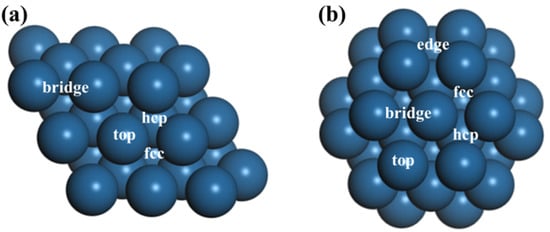
Figure 1.
Two models of Pd catalysts: (a) Pd slab model; (b) Pd38 cluster model.
3.2. Reactants and Intermediates on the Pd38 Cluster Model and Pd(111) Slab Model
The adsorption behaviors of H2 and its reaction intermediates in the two Pd models were investigated, to study the H2 catalytic combustion mechanism. The adsorption geometry of reactants, intermediates, and products in the Pd38 cluster model and Pd(111) slab model are shown in Figure 2 and Figure 3, respectively. Table 1 and Table 2 list the corresponding adsorption energies of the reactants, intermediates, and products in the Pd38 cluster model and Pd(111) slab model, respectively.
The H2 adsorption in the Pd(111) slab model exhibits four structures in Figure 2a(1)–a(4). In Figure 2a(1), the H2 adsorbed on the top site of the Pd(111) slab model, marked as H2-top, with an adsorption energy of −1.31 eV. The lengths of H-Pd bonds were 1.762 Å and 1.760 Å, respectively. In Figure 2a(2), H2 adsorbs on the bridge site of the Pd(111) slab model, marked as the H2-top, with an adsorption energy of −1.43 eV. One H atom adsorbs on a Pd atom and anther H atom adsorbs on the adjacent Pd atom. The lengths of H-Pd bonds were 1.788 Å and 1.792 Å, respectively. In Figure 2a(3), H2 adsorbs on the fcc site of the Pd(111) slab model, marked as H2-fcc. The corresponding adsorption energy was −1.66 eV. The lengths of the H-Pd bonds were 1.798 Å, 1.799 Å, and 1.799 Å, respectively. In Figure 2a(4), the adsorption structure is marked as H2-hcp, where H2 adsorbs on the fcc site of the Pd(111) slab model. The corresponding adsorption energy was −1.62 eV, which is close to that of H2-fcc. The lengths of the H-Pd bonds were 1.802 Å, 1.801 Å, and 1.801 Å, respectively. Compared to the four adsorption structures, the adsorption energies were from 1.31 eV to 1.66 eV. This indicates that the four adsorption structures were stable. The adsorption energy of H2-fcc was lowest of the four adsorption structures, which indicates that H2 prefers to adsorb on the fcc site of the Pd(111) surface. Figure 2b(1)–b(4) shows the adsorption structures of O2 on the Pd(111) surface. Similarly to the H2 adsorption on the Pd(111) surface, there were also four adsorption structures of O2 on the Pd(111) surface. O2 can also adsorb on the top, bridge, fcc, and hcp sites; marked as O2-top, O2-bridge, O2-fcc, and O2-hcp, respectively. The corresponding adsorption energies were −0.68 eV, −0.77 eV, −0.98 eV, and −0.95 eV, respectively. It can be seen that O2-fcc was the most stable adsorption structure, with the lowest adsorption energy. Figure 2c(1)–c(4) shows the H adsorption structures on the Pd(111) surface. H adsorbs on the top, bridge, fcc, and hcp sites, with adsorption energies of −2.08 eV, −2.49 eV, −2.57 eV, and −2.54 eV, respectively. H-fcc is the most stable adsorption structure, with the lowest adsorption energy of −2.57 eV. The O adsorption structures on the top, bridge, fcc, and hcp site are shown in Figure 2d(1)–d(4). The corresponding adsorption energies of the four structures were −2.37 eV, −3.06 eV, −3.25 eV, and −2.96 eV, respectively. The OH adsorption structures on the top, bridge, fcc, and hcp site are shown in Figure 2e(1)–e(4). The corresponding adsorption energies of the four structures were −1.03 eV, −1.39 eV, −1.40 eV, and −1.33 eV, respectively. In Figure 2f(1),f(2), H2O adsorbs on the top and bridge site of the Pd(111) surface, with adsorption energies of −0.36 eV and −0.59 eV, respectively. According to the calculation results, the fcc site on the Pd(111) surface is beneficial for adsorption.
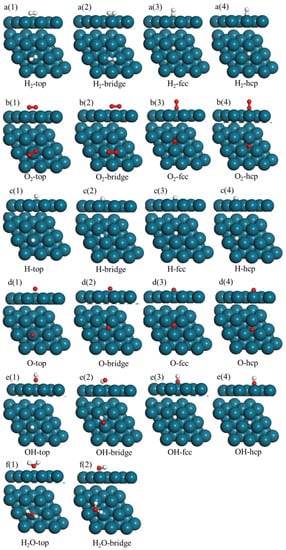
Figure 2.
Adsorption configurations of all intermediates involved in the H2 combustion reaction on the Pd(111) surface. (a(1)) H2-top adsorption; (a(2)) H2-bridge adsorption; (a(3)) H2-fcc adsorption; (a(4)) H2-hcp adsorption; (b(1)) O2-top adsorption; (b(2)) O2-bridge adsorption; (b(3)) O2-fcc adsorption; (b(4)) O2-hcp adsorption; (c(1)) H-top adsorption; (c(2)) H-bridge adsorption; (c(3)) H-fcc adsorption; (c(4)) H-hcp adsorption; (d(1)) O-top adsorption; (d(2)) O-bridge adsorption; (d(3)) O-fcc adsorption; (d(4)) O-hcp adsorption; (e(1)) OH-top adsorption; (e(2)) OH-bridge adsorption; (e(3)) OH-fcc adsorption; (e(4)) OH-hcp adsorption; (f(1)) H2O-top adsorption; (f(2)) H2O-bridge adsorption; Here, O, H, and Pd atoms are shown as red, white and blue balls, respectively, which are the same in Figure 2, Figure 3, Figure 4 and Figure 5.
Figure 3 shows the adsorption structures of adsorbates in the Pd38 cluster model. H2 adsorbs on the Pd38 cluster model shown in Figure 3a(1)–a(5). In Figure 3a(1)–a(4), H2 adsorption on the (111) surface of the Pd38 cluster is similar to that on the Pd(111) slab model. H2 adsorbs on the top, bridge, fcc, and hcp site, with adsorption energies of −1.34 eV, −1.55 eV, −1.76 eV, and −1.73 eV, respectively. Compared to that on the Pd(111) slab model, the adsorption energies of H2 on the Pd38 cluster model are lower than that of H2 on the Pd(111) slab model. This indicates that H2 prefers to adsorb on the Pd38 cluster model instead of the Pd(111) surface. In Figure 3a(5), H2 adsorbs on the edge site of the Pd38 cluster model, with an adsorption energy of −0.92 eV. The adsorption structures of O2 on the Pd38 cluster are shown in Figure 3b(1)–b(5). The adsorption energies of O2 on the top, bridge, fcc, hcp, and edge site of the Pd38 cluster were −0.83 eV, −0.95 eV, −1.06 eV, −1.02 eV, and −0.89 eV, respectively. Figure 3c(1)–c(5) shows the adsorption structures of the H atom on the top, bridge, fcc, hcp, and edge site of the Pd38 cluster, with adsorption energies of −1.14 eV, −1.38 eV, −1.57 eV, −1.54 eV, and −1.11 eV, respectively. Figure 3d(1)–d(5) shows the adsorption structures of the O atom on the top, bridge, fcc, hcp, and edge site of the Pd38 cluster, with adsorption energies of −2.45 eV, −2.59 eV, −3.62 eV, −3.56 eV, and −2.45 eV, respectively. The adsorption structures of OH on the top, bridge, fcc, hcp, and edge site of the Pd38 cluster are shown in Figure 3e(1)–e(5). The corresponding adsorption energies were −1.57 eV, −2.51 eV, −2.46 eV, −2.41 eV, and −0.61 eV, respectively. There are three adsorption structures of H2O on the top, bridge, and edge site of the Pd38 cluster. The corresponding adsorption energies were −0.36 eV, −0.59 eV, and −0.44 eV. According to the adsorption energies, adsorbates prefer to adsorb on the Pd38 cluster model than on the Pd(111) slab model. As the Pd38 cluster model is a better electron donor, the adsorption of the adsorbate is more stable [26].
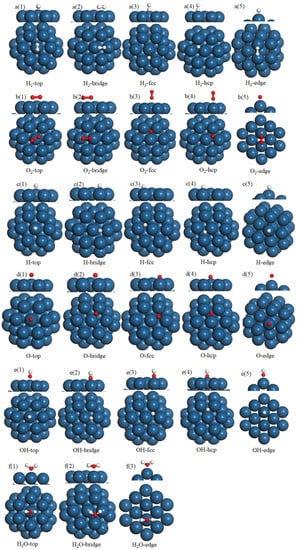
Figure 3.
Adsorption configurations of all adsorbates involved in the H2 combustion reaction on the Pd38 cluster surface. (a(1)) H2-top adsorption; (a(2)) H2-bridge adsorption; (a(3)) H2-fcc adsorption; (a(4)) H2-hcp adsorption; (a(5)) H2-edge adsorption; (b(1)) O2-top adsorption; (b(2)) O2-bridge adsorption; (b(3)) O2-fcc adsorption; (b(4)) O2-hcp adsorption; (b(5)) O2-edge adsorption; (c(1)) H-top adsorption; (c(2)) H-bridge adsorption; (c(3)) H-fcc adsorption; (c(4)) H-hcp adsorption; (c(5)) H-edge adsorption; (d(1)) O-top adsorption; (d(2)) O-bridge adsorption; (d(3)) O-fcc adsorption; (d(4)) O-hcp adsorption; (d(5)) O-edge adsorption; (e(1)) OH-top adsorption; (e(2)) OH-bridge adsorption; (e(3)) OH-fcc adsorption; (e(4)) OH-hcp adsorption; (e(5)) OH-edge adsorption; (f(1)) H2O-top adsorption; (f(2)) H2O-bridge adsorption; (f(3)) H2O-edge adsorption.
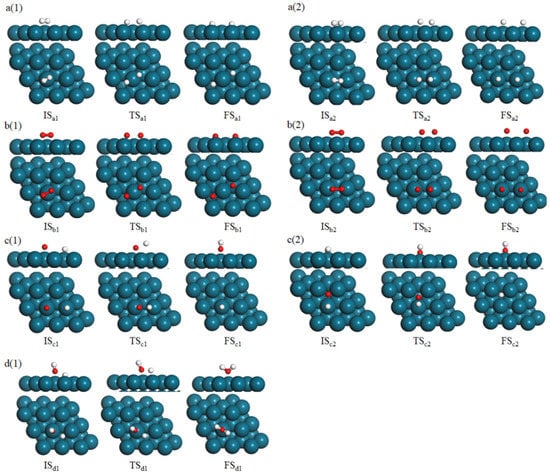
Figure 4.
Elementary steps of H2 oxidation on the Pd(111) surface: (a(1),a(2)) H2 dissociation; (b(1),b(2)) O2 dissociation; (c(1),c(2)) OH formation; (d(1)) H2O formation.
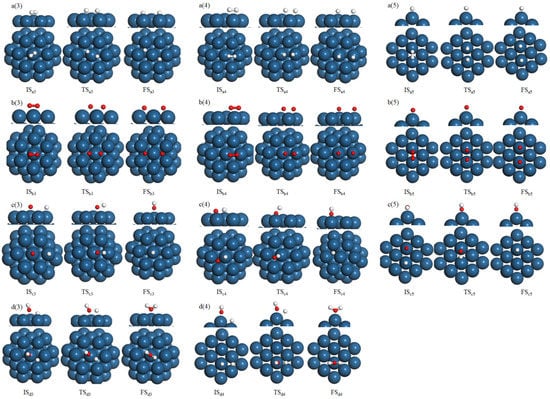
Figure 5.
Elementary steps of H2 oxidation on the Pd38 surface: (a(3),a(4),a(5)) H2 dissociation; (b(3),b(4),b(5)) O2 dissociation; (c(3),c(4),c(5)) OH formation; (d(3),d(4)) H2O formation.

Table 1.
Geometric parameters and adsorption energies of all adsorbates involved in H2 combustion on the Pd(111) slab surface.
Table 1.
Geometric parameters and adsorption energies of all adsorbates involved in H2 combustion on the Pd(111) slab surface.
| Figures | Name | Adsorption Energy/eV | Geometric Parameter/Å |
|---|---|---|---|
| Figure 2a(1) | H2-top | −1.31 | Pd1-H1:1.762; Pd1-H2:1.760 |
| Figure 2a(2) | H2-bridge | −1.43 | Pd1-H1:1.788; Pd2-H2:1.792 |
| Figure 2a(3) | H2-fcc | −1.66 | Pd1-H1:1.798; Pd2-H1:1.799; Pd3-H1:1.799 |
| Figure 2a(4) | H2-hcp | −1.62 | Pd1-H1:1.802; Pd2-H1:1.801; Pd3-H1:1.801 |
| Figure 2b(1) | O2-top | −0.68 | Pd1-O1:1.964; Pd1-O 2:1.965 |
| Figure 2b(2) | O2-bridge | −0.77 | Pd1-O1:2.019; Pd2-O 2:2.017 |
| Figure 2b(3) | O2-fcc | −0.98 | Pd1-O 1:1.972; Pd2-O 1:1.970; Pd3-O 1:1.970 |
| Figure 2b(4) | O2-hcp | −0.95 | Pd1-O 1:1.993; Pd2-O1:1.990; Pd3-O1:1.991 |
| Figure 2c(1) | H-top | −2.08 | Pd1-H:1.646 |
| Figure 2c(2) | H-bridge | −2.49 | Pd1-H:1.736; Pd2-H:1.734 |
| Figure 2c(3) | H-fcc | −2.57 | Pd1-H:1.759; Pd2-H:1.760; Pd3-H:1.760 |
| Figure 2c(4) | H-hcp | −2.54 | Pd1-H:1.768; Pd2-H:1.768; Pd3-H:1.769 |
| Figure 2d(1) | O-top | −2.37 | Pd1-O:1.938 |
| Figure 2d(2) | O-bridge | −3.06 | Pd1-O:1.998; Pd2-O:1.998 |
| Figure 2d(3) | O-fcc | −3.25 | Pd1-O:2.034; Pd2-H:2.035; Pd3-O:2.035 |
| Figure 2d(4) | O-hcp | −2.96 | Pd1-O:2.079; Pd2-O:2.079; Pd3-O:2.078 |
| Figure 2e(1) | OH-top | −1.03 | Pd1-O:1.957 |
| Figure 2e(2) | OH-bridge | −1.39 | Pd1-O:2.016; Pd2-O:2.016 |
| Figure 2e(3) | OH-fcc | −1.40 | Pd1-O:2.055; Pd2-H:2.056; Pd3-O:2.055 |
| Figure 2e(4) | OH-hcp | −1.33 | Pd1-O:2.092; Pd2-O:2.093; Pd3-O:2.093 |
| Figure 2f(1) | H2O-top | −0.36 | Pd1-O:2.105 |
| Figure 2f(2) | H2O-bridge | −0.59 | Pd1-H1:1.887; Pd2-H2:1.886 |

Table 2.
Geometric parameters and adsorption energies of all adsorbates involved in H2 combustion on the Pd38 cluster surface.
Table 2.
Geometric parameters and adsorption energies of all adsorbates involved in H2 combustion on the Pd38 cluster surface.
| Figures | Name | Adsorption Energy/eV | Geometric Parameter/Å |
|---|---|---|---|
| Figure 3a(1) | H2-top | −1.34 | Pd1-H1:1.733; Pd1-H2:1.732 |
| Figure 3a(2) | H2-bridge | −1.55 | Pd1-H1:1.745; Pd2-H2:1.752 |
| Figure 3a(3) | H2-fcc | −1.76 | Pd1-H1:1.756; Pd2-H1:1.768; Pd3-H1:1.769 |
| Figure 3a(4) | H2-hcp | −1.73 | Pd1-H1:1.781; Pd2-H1:1.794; Pd3-H1:1.795 |
| Figure 3a(5) | H2-edge | −0.92 | Pd1-H1:1.881; Pd2-H2:1.882 |
| Figure 3b(1) | O2-top | −0.83 | Pd1-O1:1.968; Pd1-O2:1.968 |
| Figure 3b(2) | O2-bridge | −0.95 | Pd1-O1:2.114; Pd2-O2:2.121 |
| Figure 3b(3) | O2-fcc | −1.06 | Pd1-O1:2.070; Pd2-O1:2.077; Pd3-O1:2.077 |
| Figure 3b(4) | O2-hcp | −1.02 | Pd1-O1:2.059; Pd2-O1:2.066; Pd3-O1:2.067 |
| Figure 3b(5) | O2-edge | −0.89 | Pd1-O1:1.993; Pd2-O2:1.994 |
| Figure 3c(1) | H-top | −1.14 | Pd1-H:1.630 |
| Figure 3c(2) | H-bridge | −1.38 | Pd1-H:1.724; Pd2-H:1.729 |
| Figure 3c(3) | H-fcc | −1.57 | Pd1-H:1.738; Pd2-H:1.756; Pd3-H:1.754 |
| Figure 3c(4) | H-hcp | −1.54 | Pd1-H:1.749; Pd2-H:1.752; Pd3-H:1.750 |
| Figure 3c(5) | H-edge | −1.11 | Pd1-H:1.688 |
| Figure 3d(1) | O-top | −2.45 | Pd1-O:1.920 |
| Figure 3d(2) | O-bridge | −2.59 | Pd1-O:1.974; Pd2-O:1.979 |
| Figure 3d(3) | O-fcc | −3.62 | Pd1-O:2.011; Pd2-H:2.017; Pd3-O:2.018 |
| Figure 3d(4) | O-hcp | −3.56 | Pd1-O:2.062; Pd2-O:2.074; Pd3-O:2.073 |
| Figure 3d(5) | O-edge | −1.73 | Pd1-O:2.122 |
| Figure 3e(1) | OH-top | −1.57 | Pd1-O:1.924 |
| Figure 3e(2) | OH-bridge | −2.51 | Pd1-O:2.001; Pd2-O:2.009 |
| Figure 3e(3) | OH-fcc | −2.46 | Pd1-O:2.022; Pd2-H:2.028; Pd3-O:2.029 |
| Figure 3e(4) | OH-hcp | −2.41 | Pd1-O:2.069; Pd2-O:2.077; Pd3-O:2.078 |
| Figure 3e(5) | OH-edge | −0.61 | Pd1-O:2.143 |
| Figure 3f(1) | H2O-top | −0.36 | Pd1-O:2.075 |
| Figure 3f(2) | H2O-bridge | −0.59 | Pd1-H1:1.869; Pd2-H2:1.869 |
| Figure 3f(3) | H2O-edge | −0.44 | Pd1-H1:1.869; Pd2-H2:1.869 |
3.3. Reaction Mechanism of H2 Catalytic Combustion on Pd38 Cluster Model and Pd(111) Slab Model
The adsorption structure of H2 catalytic combustion on the Pd(111) slab model and Pd38 cluster model was optimized, in order to analyze the H2 catalytic combustion mechanism on these two surface models. Figure 4 and Figure 5 show the H2 catalytic combustion reaction on the Pd(111) slab model and Pd38 cluster model, respectively. The corresponding activation energies are shown in Figure 6. Table 3 shows the activation energies and reaction energies of the elementary reaction steps.
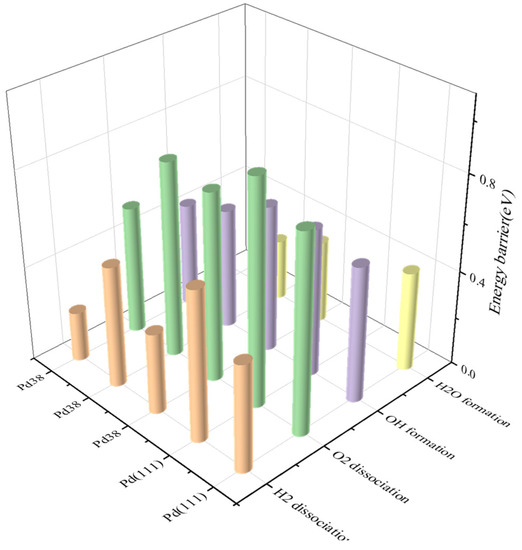
Figure 6.
Energy barriers of H2 catalytic combustion on the Pd38 cluster and Pd(111) slab.

Table 3.
Activation energies and reaction energies of the H2 catalytic combustion on the Pd38 cluster and Pd(111) slab.
The H2 dissociation process on the Pd(111) surface is shown in Figure 4a(1). The H2 is first adsorbed at the top site of the Pd(111) surface. As the reaction progresses, the length of the H-H bond is gradually elongated. Finally, the two H atoms gradually move to the hcp site on the Pd(111) surface. This elementary step is an exothermic reaction, with a reaction energy of −0.12 eV. The corresponding activation energy was 0.45 eV, which indicates that the elemental reaction proceeded relatively easily in both kinetics and thermodynamics. Another H2 dissociation process on the Pd(111) surface is shown in Figure 4a(2). H2 first adsorbs at the bridge site on the Pd(111) surface. The H-H bond length is gradually elongated as the reaction progresses. Then, two H atoms are gradually adsorbed to the top site of the two adjacent Pd atoms, respectively. The corresponding activation energy and reaction energy were 0.83 eV and −0.22 eV, respectively. The activation energy of this step was slightly higher than that in Figure 4a(1), which indicates that the H2 dissociation process on the Pd(111) surface prefers to proceed in Figure 4a(2). Similar to the two steps of H2 dissociation on the Pd(111) surface, two O2 dissociation steps on the Pd(111) surface are shown in Figure 4 (b(1),b(2). The activation energies of the two O2 dissociation steps were 0.63 eV and 0.94 eV, respectively. The corresponding reaction energies were −0.47 eV and −0.32 eV, respectively. The OH formation steps are shown in Figure 4c(1),c(2). In Figure 4c(1), H and O are adsorbed on the top site of the Pd(111) surface. As the reaction continues, O and H atoms become closer and bond to form OH. After the reaction, the OH adsorbs on the top site of the Pd(111) surface. The activation energy and reaction energy of the elemental step were 0.57 eV and −0.31 eV, respectively. In Figure 4c(2), the H atom adsorbs at the top site of the Pd(111) surface and the O atom adsorbs at the fcc site of Pd(111) surface. As the reaction progresses, the H atom gradually approaches the O atom to form OH, which adsorbs on the fcc site of the Pd(111) surface. The activation energy and reaction energy were 0.62 eV and −0.19 eV, respectively. Figure 4d(1) shows the elementary step of H2O formation on the Pd(111) surface. OH adsorbs at the top site of Pd surface and H atom adsorbs at the adjacent fcc site. H atom bonds approaches the O atom in OH, to form H2O, which adsorbs at the top site of the Pd(111) surface. The corresponding reaction activation energy and reaction energy were 0.42 eV and −0.44 eV.
The elementary steps of H2 dissociation on the Pd38 cluster surface are shown in Figure 5a(3)–a(5). The H2 dissociation process in Figure 5a(3) is similar to that in Figure 4a(1). H2 first adsorbs at the top site on the surface of the Pd38 cluster. Then, two H atoms adsorb at the hcp site on the Pd38 cluster surface after dissociation. The corresponding activation energy and reaction energy of the elemental step were 0.34 eV and −0.23 eV, respectively. The H2 dissociation step in Figure 5a(4) is similar to that in Figure 4a(2), with activation and reaction energies of 0.51 eV and −0.29 eV, respectively. In Figure 5a(5), H2 first adsorbs on the edge site of the Pd38 cluster surface. Then, H-H is gradually elongated until breakage with the ongoing reaction. Finally, two H atoms dissociate and adsorb on the edge site of Pd38 cluster. The activation energy and reaction energy of the elemental step were 0.21 eV and −0.32 eV, respectively. This elementary step in Figure 5a(5) has the lowest activation energy in the five elementary steps (a(1) to a(5) of H2 dissociation. This indicates that H2 dissociates more easily on the edge site of the Pd38 cluster. The O2 dissociation steps on the Pd38 cluster surface are shown in Figure 5b(3)–b(5). The O2 dissociation steps on the Pd38 cluster are shown in Figure 5b(3),b(4) and are similar to those shown in Figure 4b(1),b(2). O2 begins to dissociate from the top site on the Pd38 cluster surface in Figure 5b(3), while O2 dissociates from the bridge site on Pd38 cluster surface in Figure 5b(4). The activation energy and reaction energy of the O2 dissociation process in Figure 5b(3) are 0.79 eV and −0.42 eV, respectively. In Figure 5b(4), the activation energy and reaction energy of the O2 dissociation process are 0.82 eV and −0.35 eV, respectively. Figure 5b(5) shows the O2 dissociation step on the edge site of the Pd38 cluster, in which two dissociated O atoms adsorb on the edge of the Pd38 cluster. The corresponding activation energy and reaction energy were 0.54 eV and −0.50 eV, respectively. Figure 5c(3)–c(5) shows the OH formation process on the Pd38 cluster. The OH formation process shown in Figure 5c(3),c(4) is similar to that shown in Figure 4c(1),c(2). As the reaction progresses, the O atom and H atom move closer to each other, to form OH, which vertically adsorbs on the fcc site and hcp site of the Pd38 cluster in Figure 5c(3),c(4), respectively. The corresponding activation energy of OH formation on the Pd38 cluster is lower than that on Pd(111). The OH formation step on the edge site of the Pd38 cluster is shown in Figure 5c(5). The activation energy and reaction energy were 0.44 eV and −0.32 eV, respectively. Figure 5d(3),d(4) shows the H2O formation step on the Pd38 cluster. The formation process of H2O in Figure 5d(3) is similar to that in Figure 4d(1). The activation energy and reaction energy were 0.62 eV and −0.33 eV, respectively. Figure 5d(4) shows the H2O formation step on the edge site of Pd38 cluster. OH first adsorbs on the edge site and the H atom adsorbs on the fcc site. As the reaction progresses, the H atom approaches the O atom of OH, to form H2O, which adsorbs on the edge of the Pd38 cluster.
The activation energies of each elementary reaction step are shown in Figure 6. Compared to the activation energies of each step, the activation energy of H2 catalytic combustion on the Pd38 cluster is lower than that on the Pd(111) surface. As seen in Figure 6, the activation energy of the O2 dissociation step is the highest in the four steps, which is the rate-determining step in the H2 catalytic combustion. The lowest activation energy of O2 dissociation was 0.83 eV on the Pd(111) surface and 0.54 eV on Pd38 cluster. These results indicate that the Pd38 cluster model had a better catalytic activity than the Pd(111) slab model. The results show that H2 catalytic oxidation is easier to carry out on Pd nanoparticles. Pd small cluster particles play an important role in improving the catalytic activity. This result is consistent with Singh’s work [6], where a low Pd loading catalyst showed a low activation energy for H2 catalytic combustion. In addition, the activation energy of H2 combustion on the edge site of the Pd38 cluster model was lower than that on the other site, which indicates that the defect sites of the catalytic particles are more conducive to the catalytic reaction. The results show that the catalytic activity is related to the dispersion of the catalytic center in the nanoparticles.
4. Conclusions
The reaction mechanisms of H2 catalytic combustion on the Pd38 cluster model and Pd(111) slab model were investigated using density functional theory. The activation energies of the H2 catalytic combustion in the Pd38 cluster model were lower than those in the Pd(111) slab model. Compared to the activation energies, H2 prefers to react on the Pd38 cluster model, especially at the edge sites of the Pd38 cluster model. The activation energy of the rate-determining step was only 0.54 eV, which was much lower than that in the Pd(111) slab model. This indicates that catalytic activity is highly related to the dispersion of the catalytic center in nanoparticles. The smaller nanoparticles with more marginal defect sites are beneficial for the H2 catalytic combustion. These results provide theoretical guidance for catalyst design for H2 oxidation combustion, which can reduce experimental costs and improve catalytic design efficiency.
Author Contributions
Conceptualization, D.Q. and X.L. (Xudong Luo); methodology, D.Q.; software, H.S.; validation, Y.Y.; formal analysis, N.Q.; investigation, X.L. (Xiaojun Lu); resources, Y.Y.; data curation, D.Q.; writing—original draft preparation, D.Q.; writing—review and editing, H.C.; visualization, D.Q.; supervision, X.L. (Xudong Luo); project administration, X.L. (Xudong Luo); funding acquisition, X.L. (Xudong Luo). All authors have read and agreed to the published version of the manuscript.
Funding
This work was supported by National Natural Science Foundation of China (NSFC, Grant No. 51772139).
Institutional Review Board Statement
Not applicable.
Informed Consent Statement
Not applicable.
Data Availability Statement
Exclude this statement.
Conflicts of Interest
The authors declare no conflict of interest.
References
- Pfefferle, W.C. The catalytic combustor—An approach to cleaner combustion (by reaction control in gas turbine engines). J. Energy 2012, 2, 142–146. [Google Scholar]
- Pangborn, J.; Scott, M.; Sharer, J. Technical prospects for commercial and residential distribution and utilization of hydrogen. Int. J. Hydrogen Energy 1977, 2, 431–445. [Google Scholar]
- Kramer, J.F.; Reihani, S.A.S.; Jackson, G.S. Low-temperature combustion of hydrogen on supported Pd catalysts. Proc. Combust. Inst. 2002, 29, 989–996. [Google Scholar] [CrossRef]
- Zhang, C.M.; Zhang, J.; Ma, J.X. Hydrogen catalytic combustion over a Pt/Ce0.6Zr0.4O2/MgAl2O4 mesoporous coating monolithic catalyst. Int. J. Hydrogen Energy 2012, 37, 12941–12946. [Google Scholar] [CrossRef]
- Shinde, V.M.; Madras, G. Nanostructured Pd modified Ni/CeO2 catalyst for water gas shift and catalytic hydrogen combustion reaction. Appl. Catal. B 2013, 132, 28–38. [Google Scholar] [CrossRef]
- Singh, S.A.; Vishwanath, K.; Madras, G. Role of Hydrogen and Oxygen Activation over Pt and Pd-Doped Composites for Catalytic Hydrogen Combustion. ACS Appl. Mater. Interfaces 2017, 9, 19380–19388. [Google Scholar]
- Zhou, J.H.; Wang, Y.; Yang, W.J.; Liu, J.Z.; Wang, Z.H.; Cen, K.F. Combustion of hydrogen-air in catalytic micro-combustors made of different material. Int. J. Hydrogen Energy 2009, 34, 3535–3545. [Google Scholar] [CrossRef]
- Du Preez, S.P.; Jones, D.R.; Bessarabov, D.G.; Falch, A.; Quaresma, C.M.D.; Dunnill, C.W. Development of a Pt/stainless steel mesh catalyst and its application in catalytic hydrogen combustion. Int. J. Hydrogen Energy 2019, 44, 27094–27106. [Google Scholar] [CrossRef]
- Fernández, A.; Arzac, G.; Vogt, U.; Hosoglu, F.; Borgschulte, A.; de Haro, M.J.; Montes, O.; Züttel, A. Investigation of a Pt containing washcoat on SiC foam for hydrogen combustion applications. Appl. Catal. B 2016, 180, 336–343. [Google Scholar] [CrossRef] [Green Version]
- Wang, S.; Chen, L.; Niu, F.; Chen, D.; Qin, L.; Sun, X.; Huang, Y. Catalytic combustion of hydrogen for residential heat supply application. Int. J. Energy Res. 2016, 40, 1979–1985. [Google Scholar]
- Fumey, B.; Buetler, T.; Vogt, U.F. Ultra-low NO emissions from catalytic hydrogen combustion. Appl. Energy 2018, 213, 334–342. [Google Scholar] [CrossRef]
- Nguyen, V.N.; Deja, R.; Peters, R.; Blum, L.; Stolten, D. Study of the catalytic combustion of lean hydrogen-air mixtures in a monolith reactor. Int. J. Hydrogen Energy 2018, 43, 17520–17530. [Google Scholar] [CrossRef]
- Arzac, G.M.; Montes, O.; Fernandez, A. Pt-impregnated catalysts on powdery SiC and other commercial supports for the combustion of hydrogen under oxidant conditions. Appl. Catal. B 2017, 201, 391–399. [Google Scholar] [CrossRef] [Green Version]
- Zheng, X.; Mantzaras, J.; Bombach, R. Kinetic interactions between hydrogen and carbon monoxide oxidation over platinum. Combust. Flame 2014, 161, 332–346. [Google Scholar] [CrossRef]
- Han, S.M.; Mullins, C.B. Catalytic Reactions on Pd-Au metallic Model Catalysts. Accounts Chem. Res. 2021, 54, 379–387. [Google Scholar] [CrossRef] [PubMed]
- Morfin, F.; Sabroux, J.C.; Renouprez, A. Catalytic combustion of hydrogen for mitigating hydrogen risk in case of a severe accident in a nuclear power plant: Study of catalysts poisoning in a representative atmosphere. Appl. Catal. B 2004, 47, 47–58. [Google Scholar] [CrossRef]
- Sandeep, K.C.; Bhattacharyya, R.; Warghat, C.; Bhanja, K.; Mohan, S. Experimental investigation on the kinetics of catalytic recombination of hydrogen with oxygen in air. Int. J. Hydrogen Energy 2014, 39, 17906–17912. [Google Scholar] [CrossRef]
- Qi, W.J.; Ran, J.Y.; Wang, R.R.; Du, X.S.; Shi, J.; Ran, M.C. Kinetic mechanism of effects of hydrogen addition on methane catalytic combustion over Pt(111) surface: A DFT study with cluster modeling. Comput. Mater. Sci. 2016, 111, 430–442. [Google Scholar] [CrossRef]
- Sui, R.; Liang, W.K.; Zhang, L.; Mantzaras, J.; Law, C.K. Kinetic interactions between H-2 and CO in catalytic oxidation over PdO. Combust. Flame 2020, 211, 270–280. [Google Scholar] [CrossRef]
- Tsamis, C.; Tsoura, L.; Nassiopoulou, A.; Travlos, A.; Salmas, C.; Hatzilyberis, K.; Androutsopoulos, G. Hydrogen catalytic oxidation reaction on Pd-doped porous silicon. IEEE Sens. J. 2002, 2, 89–95. [Google Scholar] [CrossRef]
- Abate, S.; Barbera, K.; Centi, G.; Giorgianni, G.; Perathoner, S. Role of size and pretreatment of Pd particles on their behaviour in the direct synthesis of H2O2. J. Energy Chem. 2016, 25, 9. [Google Scholar] [CrossRef]
- Huang, L.; Wang, Z.; Tan, J. New insights into catalysis for Heck reactions with fine supported Pd particles. React. Chem. Eng. 2020, 5, 921–934. [Google Scholar] [CrossRef]
- Chen, H.; Wu, Y.L.; Qi, S.T.; Chen, Y.; Yang, M.D. Deoxygenation of octanoic acid catalyzed by hollow spherical Ni/ZrO2. Appl. Catal. A 2017, 529, 79–90. [Google Scholar] [CrossRef]
- Wang, B.J.; Song, L.Z.; Zhang, R.G. The dehydrogenation of CH4 on Rh(111), Rh(110) and Rh(100) surfaces: A density functional theory study. Appl. Surf. Sci. 2012, 258, 3714–3722. [Google Scholar] [CrossRef]
- Zhang, R.G.; Song, L.Z.; Wang, Y.H. Insight into the adsorption and dissociation of CH4 on Pt(h k l) surfaces: A theoretical study. Appl. Surf. Sci. 2012, 258, 7154–7160. [Google Scholar] [CrossRef]
- Qi, D.; Luo, X.; Yao, J.; Yao, Y.; Lu, X. Computational study of CO catalytic oxidation on Pd38 cluster model and Pd slab model. J. Fuel Chem. Technol. 2020, 48, 9. [Google Scholar]
- Wang, D.S.; Li, Y.D. Bimetallic Nanocrystals: Liquid-Phase Synthesis and Catalytic Applications. Adv. Mater. 2011, 23, 1044–1060. [Google Scholar] [CrossRef] [PubMed]
Publisher’s Note: MDPI stays neutral with regard to jurisdictional claims in published maps and institutional affiliations. |
© 2022 by the authors. Licensee MDPI, Basel, Switzerland. This article is an open access article distributed under the terms and conditions of the Creative Commons Attribution (CC BY) license (https://creativecommons.org/licenses/by/4.0/).